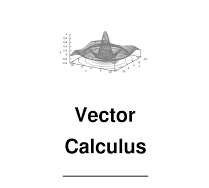
Operator notations

Gradient:
In the three-dimensional Cartesian coordinate variables, the gradient of some function f(x,y,z) is given by:
$$ \text{grad}(f)=\nabla f=(\frac {\partial}{\partial x},\frac {\partial}{\partial y},\frac {\partial}{\partial z})f= \frac {\partial f}{\partial x}i+\frac {\partial f}{\partial y}j+\frac {\partial f}{\partial z}k $$
where i, j, k are the standard unit vectors for the x, y, z-axes.
More generally, for a function of n variables ψ(x1,…,xn), also called a scalar field, the gradient is the vector field:
$$ \nabla \psi= \left(\frac {\partial}{\partial x_1},\cdots,\frac {\partial}{\partial x_n} \right)\psi = \frac {\partial \psi}{\partial x_1}e_1+\cdots+\frac {\partial \psi}{\partial x_n}e_n $$
where ei are orthogonal unit vectors in arbitrary directions.
For a vector field A=(A1,…,An) written as a 1 × n row vector, also called a tensor field of order 1, the gradient or covariant derivative is the n × n Jacobian matrix:
$$ \nabla A= J_A = \left ( \frac {\partial A_i}{\partial x_j}\right )_{ij} $$
The gradient of a tensor field, A of any order k, is generally written as: grad(A)=∇A and is a tensor field of order k + 1.
Divergence:
In three-dimensional Cartesian coordinates, the divergence of a continuously differentiable vector field F=Fxi+Fyj+Fzk is the scalar-valued function:
$$ \text{div}F=\nabla \cdot F=(\frac {\partial}{\partial x},\frac {\partial}{\partial y},\frac {\partial}{\partial z})\cdot (F_x,F_y,F_z)= \frac {\partial F_x}{\partial x}i+\frac {\partial F_y}{\partial y}j+\frac {\partial F_z}{\partial z}k $$
The divergence of a tensor field A of non-zero order k is written as
$$ \text{div}A=\nabla \cdot A $$
and is a contraction to a tensor field of order k − 1. Specifically, the divergence of a vector is a scalar. The divergence of a higher order tensor field may be found by decomposing the tensor field into a sum of outer products and using the identity,
$$ \nabla \cdot \left( B \otimes \hat A \right)= \hat A (\nabla \cdot B) + (B \cdot \nabla)\hat A $$
where B⋅∇ is the directional derivative in the direction of B multiplied by its magnitude. Specifically, for the outer product of two vectors,
$$ \nabla \cdot (ba^T)=a(\nabla \cdot b)+(b\cdot \nabla)a $$
Curl:
In Cartesian coordinates, for F=Fxi+Fyj+Fzk the curl is the vector field:
$$ \text{curl}F=\nabla \times F=(\frac {\partial}{\partial x},\frac {\partial}{\partial y},\frac {\partial}{\partial z})\times (F_x,F_y,F_z)= \left| \matrix{ i & j & k \cr \frac {\partial}{\partial x} & \frac {\partial}{\partial y} & \frac {\partial}{\partial z} \cr F_x & F_y & F_z } \right| $$
$$ = \left ( \frac {\partial F_z}{\partial y} - \frac {\partial F_y}{\partial z} \right) i+\left ( \frac {\partial F_x}{\partial z} - \frac {\partial F_z}{\partial x} \right)j+\left ( \frac {\partial F_y}{\partial x} - \frac {\partial F_x}{\partial y} \right)k $$
where i, j, and k are the unit vectors for the x-, y-, and z-axes, respectively.
In Einstein notation, the vector field F=(F1 F2 F3)has curl given by:
$$ \nabla \times F = \varepsilon^{ijk}e_i \frac {\partial F_k}{\partial x^j} $$
where ε is the Levi-Civita parity symbol.
Laplacian:
In Cartesian coordinates, the Laplacian of a function f(x,y,z) is
$$ \Delta f= \nabla^2f = (\nabla \cdot \nabla)f= \frac {\partial^2f}{\partial x^2} + \frac {\partial^2f}{\partial y^2} + \frac {\partial^2f}{\partial z^2} $$
For a tensor field, A, the Laplacian is generally written as:
$$ \Delta A=\nabla^2A=(\nabla \cdot \nabla)A $$
and is a tensor field of the same order.
When the Laplacian is equal to 0, the function is called a Harmonic Function. That is,
$$ \Delta f=0 $$
Special notations:
In Feynman subscript notation,
$$ \nabla_B(A \cdot B)=A \times (\nabla \times B)+(A \cdot \nabla)B $$
where the notation ∇B means the subscripted gradient operates on only the factor B. Less general but similar is the Hestenes overdot notation in geometric algebra. The above identity is then expressed as:
$$ \nabla (A \cdot B)=A \times (\nabla \times B)+(A \cdot \nabla)B $$
where overdots define the scope of the vector derivative. The dotted vector, in this case B, is differentiated, while the (undotted) A is held constant.


